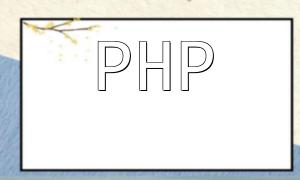Camera applications are commonly used in various fields such as video conferencing, surveillance systems, and facial recognition. In PHP, the ability to interface with a camera is often needed. This article provides a detailed explanation of how to integrate a camera into PHP applications, along with code samples to help you set up a camera-based application quickly.
Before starting, ensure you have the necessary hardware. You’ll need a computer with a camera or a mobile device that supports camera functionality. If you’re using a USB webcam, ensure that it’s properly connected to the computer.
To interface with a camera in PHP, we need to install the OpenCV library, a powerful computer vision tool. You can download the appropriate version of OpenCV from the official website (https://opencv.org).
Once downloaded and installed, you need to add the OpenCV PHP extension to your PHP environment. The installation process may vary depending on your operating system, so refer to the OpenCV documentation for specific instructions.
After installing the necessary software, we can now access the camera in PHP. Start by including the OpenCV extension in your PHP code:
<?php
// Load the OpenCV extension
extension_loaded('opencv');
?>
Next, use the `cvCreateCameraCapture()` function to create a camera object:
<?php
// Create a camera object
$camera = cvCreateCameraCapture(0);
?>
The parameter `0` indicates that we are using the default camera. If you have multiple cameras connected, you can select the appropriate one by changing this number.
To capture frames from the camera and display them, use the `cvQueryFrame()` function:
<?php
while (true) {
// Capture a frame from the camera
$frame = cvQueryFrame($camera);
// Display the frame in the browser
header('Content-type: image/jpeg');
imagejpeg($frame);
}
?>
This infinite loop will continuously capture images from the camera and display them in JPEG format in the browser. You can further modify this code to save images, perform image processing, or implement other features as needed.
Here is a complete example of how to capture video from the camera and display it in the browser:
<?php
// Load the OpenCV extension
extension_loaded('opencv');
// Create a camera object
$camera = cvCreateCameraCapture(0);
// Set the width and height of the captured frames
cvSetCaptureProperty($camera, CV_CAP_PROP_FRAME_WIDTH, 640);
cvSetCaptureProperty($camera, CV_CAP_PROP_FRAME_HEIGHT, 480);
// Create a window to display the captured video
cvNamedWindow('Camera', CV_WINDOW_NORMAL);
while (true) {
// Capture a frame from the camera
$frame = cvQueryFrame($camera);
// Display text on the frame
cvPutText($frame, 'Press ESC to exit', new CvPoint(20, 20), new CvFont(CV_FONT_HERSHEY_SIMPLEX, 0.8, 0.8));
// Display the captured frame
cvShowImage('Camera', $frame);
// Wait for user input
$key = cvWaitKey(10);
if ($key == 27) { // ESC key
break;
}
}
// Release the camera object
cvReleaseCapture($camera);
// Close the display window
cvDestroyWindow('Camera');
?>
With the above example, you can understand how to access the camera in PHP and display the live video feed in the browser. You can customize this code based on your project needs, such as saving frames, processing images, or adding additional features.
This article has provided a detailed explanation of how to access and use a camera in PHP, along with sample code to help you get started. I hope this guide helps you integrate camera functionality into your projects, enabling exciting new applications. If you have any questions or issues, feel free to leave a comment, and I will do my best to assist you.








